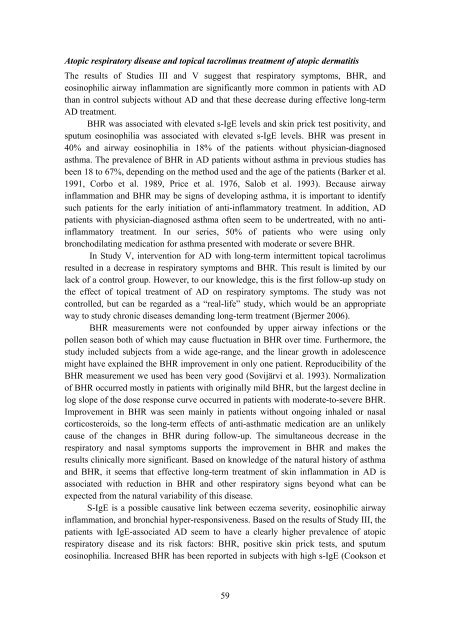Topical tacrolimus in atopic dermatitis: Effects of ... - Helda - Helsinki.fi
Topical tacrolimus in atopic dermatitis: Effects of ... - Helda - Helsinki.fi
Topical tacrolimus in atopic dermatitis: Effects of ... - Helda - Helsinki.fi
You also want an ePaper? Increase the reach of your titles
YUMPU automatically turns print PDFs into web optimized ePapers that Google loves.
Atopic respiratory disease and topical <strong>tacrolimus</strong> treatment <strong>of</strong> <strong>atopic</strong> <strong>dermatitis</strong><br />
The results <strong>of</strong> Studies III and V suggest that respiratory symptoms, BHR, and<br />
eos<strong>in</strong>ophilic airway <strong>in</strong>flammation are signi<strong>fi</strong>cantly more common <strong>in</strong> patients with AD<br />
than <strong>in</strong> control subjects without AD and that these decrease dur<strong>in</strong>g effective long-term<br />
AD treatment.<br />
BHR was associated with elevated s-IgE levels and sk<strong>in</strong> prick test positivity, and<br />
sputum eos<strong>in</strong>ophilia was associated with elevated s-IgE levels. BHR was present <strong>in</strong><br />
40% and airway eos<strong>in</strong>ophilia <strong>in</strong> 18% <strong>of</strong> the patients without physician-diagnosed<br />
asthma. The prevalence <strong>of</strong> BHR <strong>in</strong> AD patients without asthma <strong>in</strong> previous studies has<br />
been 18 to 67%, depend<strong>in</strong>g on the method used and the age <strong>of</strong> the patients (Barker et al.<br />
1991, Corbo et al. 1989, Price et al. 1976, Salob et al. 1993). Because airway<br />
<strong>in</strong>flammation and BHR may be signs <strong>of</strong> develop<strong>in</strong>g asthma, it is important to identify<br />
such patients for the early <strong>in</strong>itiation <strong>of</strong> anti-<strong>in</strong>flammatory treatment. In addition, AD<br />
patients with physician-diagnosed asthma <strong>of</strong>ten seem to be undertreated, with no anti<strong>in</strong>flammatory<br />
treatment. In our series, 50% <strong>of</strong> patients who were us<strong>in</strong>g only<br />
bronchodilat<strong>in</strong>g medication for asthma presented with moderate or severe BHR.<br />
In Study V, <strong>in</strong>tervention for AD with long-term <strong>in</strong>termittent topical <strong>tacrolimus</strong><br />
resulted <strong>in</strong> a decrease <strong>in</strong> respiratory symptoms and BHR. This result is limited by our<br />
lack <strong>of</strong> a control group. However, to our knowledge, this is the <strong>fi</strong>rst follow-up study on<br />
the effect <strong>of</strong> topical treatment <strong>of</strong> AD on respiratory symptoms. The study was not<br />
controlled, but can be regarded as a “real-life” study, which would be an appropriate<br />
way to study chronic diseases demand<strong>in</strong>g long-term treatment (Bjermer 2006).<br />
BHR measurements were not confounded by upper airway <strong>in</strong>fections or the<br />
pollen season both <strong>of</strong> which may cause fluctuation <strong>in</strong> BHR over time. Furthermore, the<br />
study <strong>in</strong>cluded subjects from a wide age-range, and the l<strong>in</strong>ear growth <strong>in</strong> adolescence<br />
might have expla<strong>in</strong>ed the BHR improvement <strong>in</strong> only one patient. Reproducibility <strong>of</strong> the<br />
BHR measurement we used has been very good (Sovijärvi et al. 1993). Normalization<br />
<strong>of</strong> BHR occurred mostly <strong>in</strong> patients with orig<strong>in</strong>ally mild BHR, but the largest decl<strong>in</strong>e <strong>in</strong><br />
log slope <strong>of</strong> the dose response curve occurred <strong>in</strong> patients with moderate-to-severe BHR.<br />
Improvement <strong>in</strong> BHR was seen ma<strong>in</strong>ly <strong>in</strong> patients without ongo<strong>in</strong>g <strong>in</strong>haled or nasal<br />
corticosteroids, so the long-term effects <strong>of</strong> anti-asthmatic medication are an unlikely<br />
cause <strong>of</strong> the changes <strong>in</strong> BHR dur<strong>in</strong>g follow-up. The simultaneous decrease <strong>in</strong> the<br />
respiratory and nasal symptoms supports the improvement <strong>in</strong> BHR and makes the<br />
results cl<strong>in</strong>ically more signi<strong>fi</strong>cant. Based on knowledge <strong>of</strong> the natural history <strong>of</strong> asthma<br />
and BHR, it seems that effective long-term treatment <strong>of</strong> sk<strong>in</strong> <strong>in</strong>flammation <strong>in</strong> AD is<br />
associated with reduction <strong>in</strong> BHR and other respiratory signs beyond what can be<br />
expected from the natural variability <strong>of</strong> this disease.<br />
S-IgE is a possible causative l<strong>in</strong>k between eczema severity, eos<strong>in</strong>ophilic airway<br />
<strong>in</strong>flammation, and bronchial hyper-responsiveness. Based on the results <strong>of</strong> Study III, the<br />
patients with IgE-associated AD seem to have a clearly higher prevalence <strong>of</strong> <strong>atopic</strong><br />
respiratory disease and its risk factors: BHR, positive sk<strong>in</strong> prick tests, and sputum<br />
eos<strong>in</strong>ophilia. Increased BHR has been reported <strong>in</strong> subjects with high s-IgE (Cookson et<br />
59

















